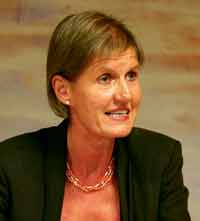Welsh chief vet reveals more detail on badger cull

The chief veterinary officer for Wales, Christianne Glossop, has given the strongest indication yet of the Welsh badger culling trial’s location.
It was already known that the trial would be in North Pembrokeshire but Prof Glossop has now publicly announced that the trial area would be 29% bordered by the coast, used the Preseli hills as one boundary and two rivers, one large and one smaller, as the other two boundaries.
She made the announcement after receiving this year’s RABDF Princess Royal Award for services to the industry and added that the trial ran up to the county boundary with Ceredigion.
This could mean the proposed cull area is bounded by the River Teifi in the north, the Preseli hills in the east and the River Gwaun in the south.
However, she said the Welsh Assembly Government wouldn’t be producing a map of the area to maintain the security of those undertaking the culling.
“One part of the boundary is, unfortunately, open farmland. But we have ensured where possible that no cattle farms are on the boundary and where farms are split by the area the line has been moved to ensure the whole farm is inside the area.”
For those farmers who did have land inside and outside the culling area on sole occupancy authority agreements (SOAs), these would be revoked to prevent movement of cattle into the culling area without pre-movement testing.
The proposed cull of badgers in an area of North Pembrokeshire was on track to begin this spring, although there has been no firm date set yet, Prof Glossop said. “We have contacted the 1500 landowners in the area and only 30 have raised any objection to the cull. Badger sett surveys are ongoing at the moment and once those are complete we’ll know if we’ll have to use compulsory powers granted under the TB Order to enter this land to carry out the cull.”
And of all the responses received to last year’s consultation on the Welsh TB stratgey, more than 80% were in favour of the measures proposed.
Asked whether she felt the English strategy should follow a similar line, Prof Glossop said she wouldn’t presume to tell to English ministers what to do. “I would presume to show them what we are doing, however.”
Vaccination may well become part of the Welsh strategy in due course, but only in non-infected populations, she added. “Vaccination is a great tool in preventing disease, but where disease already exists it isn’t a very effective tool. You need to use vaccination in populations which are at risk but relatively disease-free.
“This is particularly true with the vaccine being used in England, which is only about 60% effective. Imagine a scenario where 25% of the population is infected. When you vaccinate in that population then only 75% of the population has any chance of responding to the vaccine and only 60% of them will produce sufficient antibodies. So less than half of the original population is protected by the vaccine,” explained Prof Glossop.
But, while badger culling may be the measure which has caught the headlines, it is only one part of the Welsh strategy to eradicate TB from the nation’s cattle.
Prof Glossop, joint winner of last year’s NFU/Farmers Weekly Farming Champion award, was quick to remind farmers that they had their part to play too, most importantly in limiting cattle-to-cattle spread of disease through improved herd health management and more informed purchasing decisions. “Our TB eradication work in Wales began two years ago and has so far focused heavily on cattle measures. A key part of this has been to help farmers recognise their role and responsibility in limiting disease spread.”
In some parts of Wales wildlife vectors actually have little if any impact on TB spread with cattle movements by far the greater risk, she added.
